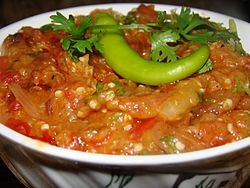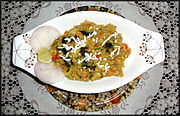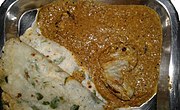food.wikisort.org - Dish
Baingan bharta (mashed eggplant)[lower-alpha 1] is an Indian dish prepared by mincing grilled eggplant (baingan) and mixing it with tomato, onion, herbs and spices. Grilling the eggplant over charcoal or direct fire infuses the dish with a smoky flavour. Mashed eggplant is then mixed with cooked chopped tomato, browned onion, ginger, garlic, cumin, fresh cilantro (coriander leaves), chili pepper, and mustard oil or a neutral vegetable oil.[1] Traditionally, the dish is often eaten with flatbread (specifically roti or paratha) and is also served with rice or raita, a yogurt salad. In Bihar and Uttar Pradesh, it is served hot with litti or baati.[2]
 Baignan bharta | |
| Alternative names | Begun bhorta |
|---|---|
| Place of origin | India |
| Region or state | South Asia |
| Main ingredients | Eggplant, onion, tomato, chili, Pakistani spices |
In India, Pakistan and Bangladesh, baingan bharta is part of popular cuisine. In India, it is made in various regional styles, with ingredients varying from one region to another.
Names
The dish has several regional names, such as: baingan ka bharta (Hindi: बैंगन का भरता, Urdu: بینگن کا بھرتہ), baingan da bharrtha (Punjabi: ਬੈਂਗਣ ਦਾ ਭੱੜਥਾ), ringan no oro (Gujarati: રીંગણનો ઓળો), pura begena satoni (Assamese: পুৰা বেঙেনা চাটনি) or bengena pitika (Assamese: বেঙেনা পিটিকা), wangyacha bharit (Marathi: वांग्याचं भरीत), ennegayi (Kannada: ಎಣ್ಣೆಗಾಯಿ), baigana bhartta (Odia: ବାଇଗଣ ଭର୍ତ୍ତା), begun bhôrta (Bengali: বেগুন ভর্তা), baingoin satni (Sylheti: ꠛꠣꠁꠋꠉꠂꠘ ꠌꠣꠐꠘꠤ) and olo (Gujarati).
Variants
In Gujarat, it is called Ringan No Oro (Gujarati: રીંગણનો ઓળો), in which the eggplant is roasted, then mashed, and then sautéed with mustard and cumin seeds, turmeric, red chilli powder, ginger and garlic and salt. It is served with bajra no rotlo (Gujarati: બાજરાંનો રોટલો), kadhi (a soup prepared by gram flour, curd and spices), khichadi and chhaash (Gujarati: છાશ) (buttermilk).
In Karnataka, it is called eṇṇegāyi and prepared by boiling and frying whole eggplant usually served with akki rotti. In the South Indian state of Tamil Nadu, the Tamils prepare a similar dish called kathrikai thayir kothsu, in which the eggplant is cooked, mashed, and sautéed with mustard, red chilis and sesame oil. The final step in the recipe involves adding yogurt (curds) to the mixture and dressing the dish with coriander leaves.
In the Bhojpuri-speaking regions of India (such as eastern Uttar Pradesh and western Bihar), it is known as baigan ka chokha;[3] it is also popular within the Indo-Caribbean communities of Trinidad and Tobago, Suriname, and Guyana, where many descendants of indentured labourers from northern India live.
In Maharashtra, especially in the northern Khandesh region, vangyache bharit as they call it is served in social gatherings including wedding ceremonies. During harvest season, a special "bharit party" is organised. Bharit is usually served with puri. In the Vidarbha and Khandesh regions of Maharashtra, two variants are popular: kachha ("raw") bharit and phodni cha (with tadka) bharit. In kachha bharit, all the ingredients except for eggplant are used uncooked. Raw spring onion, tomato, green chillies, green coriander, and sometimes fresh fenugreek leaves are mixed with flame-roasted eggplant along with raw linseed oil or peanut oil. In phodni cha bharit, the above ingredients are first fried in oil with spices; then, mashed eggplants are mixed into it and cooked together. The similar process is followed in other Indian states and Pakistan with slight variations on ingredients. In Vidarbha and Khandesh, it is considered a delicacy when the eggplants are roasted on a dried cotton plant stems, a process which gives a distinct smokey flavour to the dish. The dish is served with dal, bhakri, and rice.
- Baingan bharta with roti and lentils
- Litti chokha, litti with baigan bharta, a North Indian dish
- Baigan bharta made in Nagpur, Maharashtra
- Akki rotti with eṇṇegāyi, a Karnataka dish
Protest symbol
In a protest against BT Brinjal and the introduction of genetically modified crops, volunteers from Greenpeace and Delhi's Le Méridien hotel cooked 342 kilograms (754 lb) of organic brinjal bharta at Dilli Haat, New Delhi, on 6 September 2011. This set a world record for the largest amount of the dish produced in one occasion of preparation. A portion of the final dish was sent to Indian Prime Minister Manmohan Singh's residence, accompanied by a letter of protest containing an explanation.[4][5]
Notes
- Or else: Baingan ka Shahi Bharta or Baingan da Bhartha
See also
- Baba ghanoush, Middle Eastern recipe from baked eggplant
- List of eggplant dishes
References
- Jaffrey, Madhur (2011). An Invitation to Indian Cooking. Alfred A. Knopf. p. 162. ISBN 978-0-375-71211-1.
- KUMAWAT, LOVESH (18 May 2020). CUISINE. NotionPress. ISBN 978-1-64850-162-3.
- Kumari, Arunima (19 January 2021). Encyclopedia of Bihar. Prabhat Prakashan. ISBN 978-93-5048-390-9.
- "Protesters say no to BT Brinjal in a unique way". Hindustan Times. 6 September 2011. Archived from the original on 3 January 2013.
- "Giant Baigan ka Bharta makes for a delicious record". The Times of India. 7 September 2011. Archived from the original on 7 November 2011.
External links
Другой контент может иметь иную лицензию. Перед использованием материалов сайта WikiSort.org внимательно изучите правила лицензирования конкретных элементов наполнения сайта.
WikiSort.org - проект по пересортировке и дополнению контента Википедии











